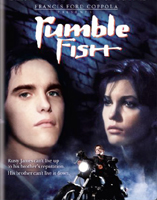 BUY IT AT AMAZON: CLICK HERE!
BUY IT AT AMAZON: CLICK HERE!
STUDIO: Universal
MSRP: $19.98
RATED: R
RUNNING TIME: 95 min.
SPECIAL FEATURES:
• Deleted Scenes
• Director Commentary
• On Location in Tulsa
• The Percussion-Based Score
• “Don’t Box Me In” Music Video
• Theatrical Trailer
With the completion of The Outsiders (DVD review HERE), Francis Ford Coppola had a good thing going. Adaptation of a second S.E. Hinton book began immediately, with many of the same cast and crew carrying over to the new production with less than a month’s time off. For Coppola, this was both an opportunity to experiment with new filmmaking technologies and to work closely with several members of his family.

"Message for Mr. Cage. Someone named Woo."
The Flick
Rusty James (Matt Dillon) is a Tulsa teenager with a drinking game for a name. He lives to run with gangs and get in fights but struggles to escape the shadow of his long-absent older brother (Mickey Rourke), known only as The Motorcycle Boy. One night, Rusty James gets badly injured fighting a rival gang. Suddenly The Motorcycle Boy returns to save the day. But life in the real world has changed him: he’s old beyond his years and uneasy with the legendary status conferred upon him.
The other kids don’t see it. As far as they’re concerned, The Motorcycle Boy is the genuine article, and Rusty James a pale imitation. In the film’s best scene, Smokey (Nicolas Cage, in his first speaking role) takes over Rusty James’s gang without so much as throwing a punch.
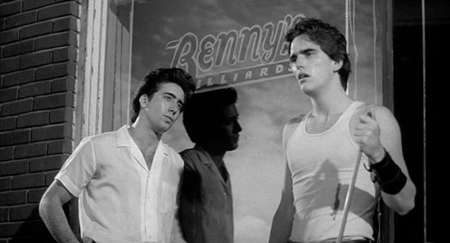
"You’re right. This IS the world’s greatest scratching stick."
Not that that means anything. Throughout the film, Coppola works to impress us that time is running out for all of these kids. Clocks appear in virtually every scene; time-lapsed clouds race overhead. For all this, Rumble Fish endeavors to be a timeless production. In fact, it’s easy to mistake it for a ‘60s period piece, which makes the appearance of a video arcade midway through somewhat jarring.
What with the constant ticking clocks, Rusty James’s Arthurian wound, and The Motorcycle Boy’s obsession with the psychology of Siamese fighting fish, it should be clear to even the casual viewer that we’re talking Allegory with a capital “A” here. Some parts of this picture almost feel like a David Lynch film– everyone’s a symbol; nobody talks or acts like a human being. Poor love interest Diane Lane gets the worst of it:

There’s also a smug, sunglasses-wearing cop (William B. Smith in the house!) with a grudge against The Motorcycle Boy. 50 eggs to the first person who figures out where that plotline is headed.
5 out of 10
The Look
If there’s one overriding reason to pick up this disc– besides the "Rusty James" drinking game, that is– this is it. Following his work lensing The Outsiders, Stephen H. Burum comes through again, this time with crisp black-and-white photography and ingenious in-camera special effects. The film’s strategic use of color and Mickey Rourke anticipates Sin City by 22 years.
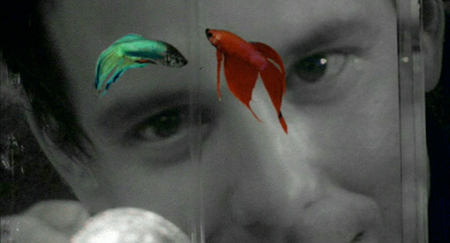
"Who you callin’ ‘Fish-Face’, stronzo?"
The 16:9 transfer is solid, and the film has been substantially cleaned up for this edition.
9 out of 10
The Noise
A new Dolby 5.1 mix highlights Police drummer Stewart Copeland’s background score. Voices frequently have a hollow echo to them but this appears to have been intentional.
7 out of 10
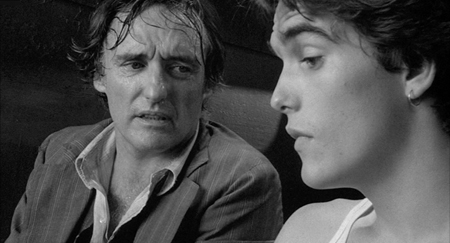
"Honest, Space Truckers is a great flick."
The Goodies
A frank Francis commentary leads the pack. Surprisingly, given its relative obscurity, this is Coppola’s favorite among his films, next to The Conversation. This is likely due more to the experience of making the movie with his children than to anything onscreen. It’s a wistful track: he speaks of his filmmaking career in the past tense and frequently cites the contributions of his son Gian-Carlo, who died only three years after the film was made.
The deleted scenes are presented on rough-cut videotape. All but one of them center on the annoyingly sensitive character Steve, obviously a surrogate for the author played by an unwisely blond Vincent Spano. He’s also about five years too old for the part.
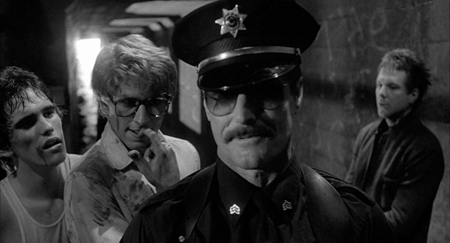
Clubber and the Punchies made the Billboard chart for a week in ’83.
The On Location documentary is of interest because it gives us a good look at Coppola’s innovative Electronic Cinema system. This was a very early version of the pre-visualization techniques employed by today’s filmmakers– the Video Blackboard is especially intriguing. There’s also some footage of the actors at work; apparently Nicolas “Jor-El” Cage has always been an intense-type guy.
The Percussion-Based Score details Stewart Copeland’s involvement in the project. This was his first film score and he won a Golden Globe for it.

Tom waits for no man.
Original theatrical trailer plus a vintage music video. Forced trailers for The Big Lebowski SE and that goddamn Carlito’s Way prequel.
8 out of 10
The Artwork
Photoshop flop as a motorcycling Mickey dodges floating heads and a badly-placed tagline. The original poster would have done just fine.
4 out of 10

…and Matt suddenly knew what to make for Science Fair.